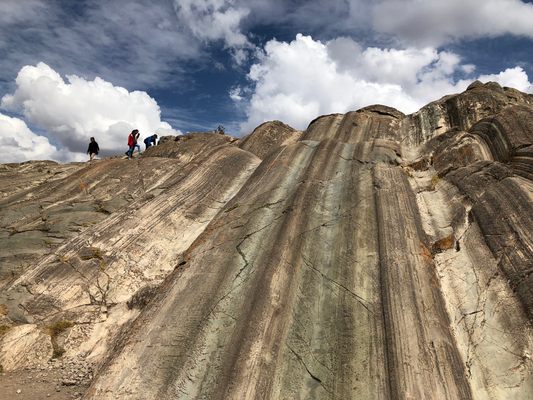About
Across from the imposing Inca citadel of Sacsayhuamán is a huge rock formation in which the Incas carved benches, steps, altars, and various other ceremonial features. Just as striking as these manmade additions are the natural slides that undulate their way down the hill.
Built by the Killke culture and later expanded by the Incas, Sacsayhuamán served as both a military and ceremonial complex. Stroll across the main plaza to the north of the citadel’s massive zigzagging walls and you’ll come to the Rodadero, also known as the Suchuna, a huge geological formation of diorite rock.
In Spanish and Quechua respectively, Rodadero and Suchuna mean “slide.” The names refer to a series of smooth rock channels that run down one section of the hill.
The well-polished slides are a strange, incongruous sight among the straight lines of monumental Inca architecture. Even more inconsistent with Sacsayhuamán’s general vibe of military power and somber ceremony are the kids—and adults—happily sliding their way down the rock chutes.
Inca Garcilaso de la Vega, a 16th-century chronicler and illegitimate offspring of a Spanish aristocrat and Inca royalty, remembered the Rodadero slides well. According to Garcilaso, Inca children, himself included, once slid down these polished grooves in just the same way as today’s visitors, which kind of makes the Rodadero a 600-year-old amusement park.
According to Moores and Wahl in The Art of Geology, three theories have been advanced to explain the formation of the “toboggan slide”: glacial, volcanic, and structural. Formation by glacier is unlikely, they argue, as “the nearest evidence of local glaciation occurs at least 250 metres above the Rodadero.” They also dismiss the idea that the grooves were formed by flowing lava, as the hill itself is not made of volcanic rock. That leaves structural: “Most likely, the grooves formed when blocks of rock moved past each other along a fault. The hill probably is the polished surface of an almost flat fault.”
That polishing likely continued for at least the last few centuries, thanks to humankind’s propensity for sliding down things.
Related Tags
Peru: Machu Picchu & the Last Incan Bridges
Discover Inca Wonders.
Book NowCommunity Contributors
Added By
Published
January 10, 2018


































